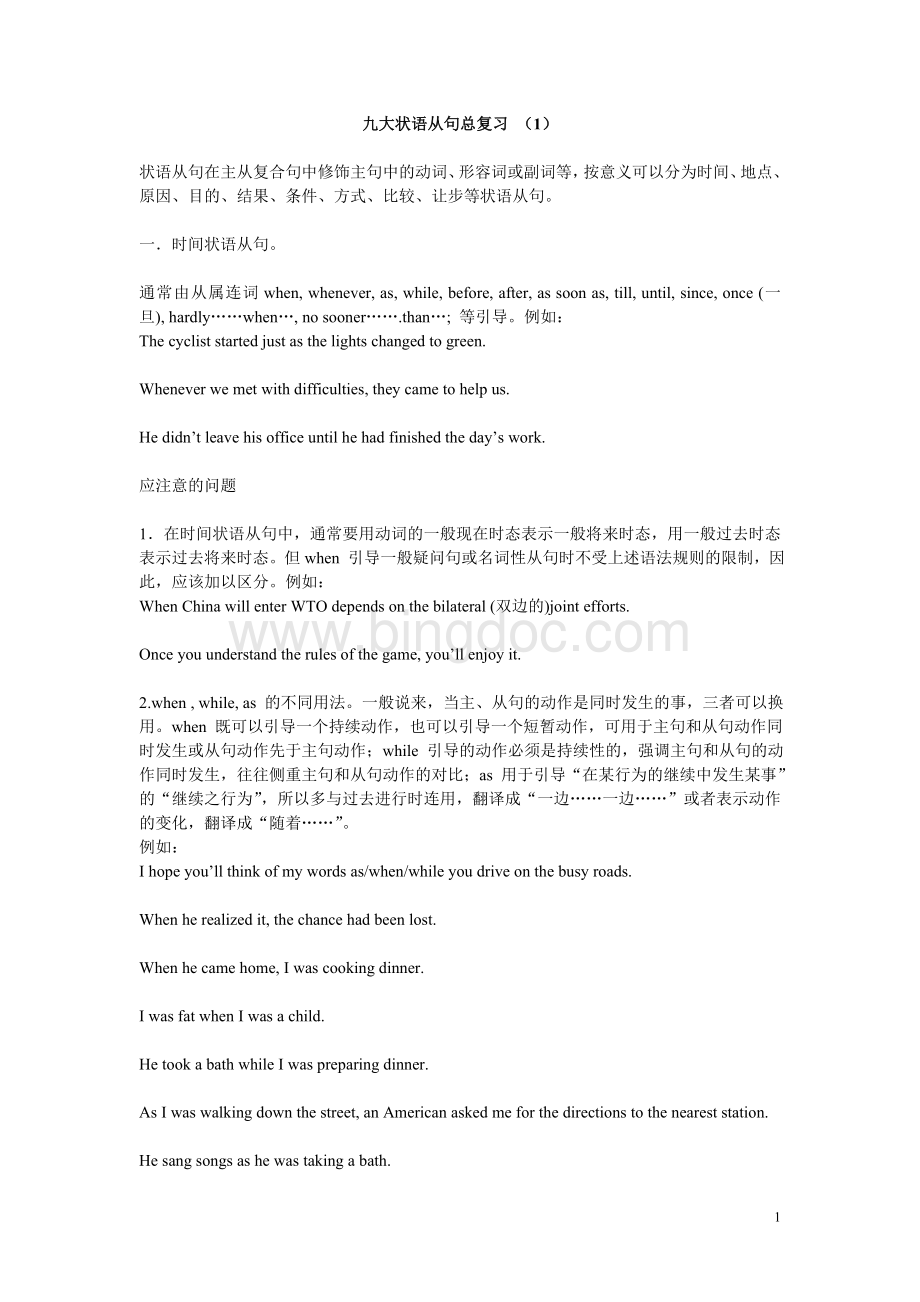九大状语从句总复习Word文件下载.doc
《九大状语从句总复习Word文件下载.doc》由会员分享,可在线阅读,更多相关《九大状语从句总复习Word文件下载.doc(8页珍藏版)》请在冰点文库上搜索。

as用于引导“在某行为的继续中发生某事”的“继续之行为”,所以多与过去进行时连用,翻译成“一边……一边……”或者表示动作的变化,翻译成“随着……”。
Ihopeyou’llthinkofmywordsas/when/whileyoudriveonthebusyroads.
Whenherealizedit,thechancehadbeenlost.
Whenhecamehome,Iwascookingdinner.
IwasfatwhenIwasachild.
HetookabathwhileIwaspreparingdinner.
AsIwaswalkingdownthestreet,anAmericanaskedmeforthedirectionstotheneareststation.
Hesangsongsashewastakingabath.
Ashegetsolderhegetsmoreoptimistic.
另外还必须注意when和while的特殊用法。
when可以表示“就在这时,突然”之意;
而while则可以表示对比的含义,常可译作“而”。
ShethoughtIwastalkingaboutherdaughter,____,infact,Iwastalkingaboutmydaughter.(NMET95)
A.whomB.whereC.whichD.while
答案:
D.本句的意思是“她认为我在谈论她女儿,然而,实际上,我在谈论我女儿。
”
再如:
Iwasabouttogotobedwhenthephonerangasecondtime.
我正准备去睡觉,就在这时电话铃又响了。
3.since和before的用法区别。
两者都可用于“It+be+since/before-从句”的句型,区别在于since表示“自从……以来”,所在主、从句的谓语动词的时态关系是:
Itis/hasbeensometimesincesbdidsomething.而before的含义则是“(过了多久)才……”,主、从句的时态关系是:
Itwas/hadbeensometimebeforesbdidsth。
表示过去和将来时,两者相应的句型分别是:
Itwassometimesincesbhaddonesomething.和Itwillbesometimebeforesbdoessomething.例如:
Itwas/hadbeenyearsbeforeIcamebackfromabroad.
Itwillbefiveyearsbeforewemeetagain.
4.一些表示时间的名词词组如:
thefirsttime,thesecondtime,lasttime,themoment,theminute,theyear,everytime,eachtime,nexttime,或副词immediately,instantly,directly等也可以引导时间状语从句。
I’lltellyouaboutitthemomentyoucome.
IrecognizedhertheminuteIsawher.
I’mgoingtoseehimnexttimehecomestoShanghai.
HeleftEuropetheyearWorldWarIIbrokeout.
IgotintouchwithhimimmediatelyIreceivedhisletter.
Mysistercamedirectly(=assoonas)shegotmymessage.
5.till和until
till和until意义相同,多数情况下可以换用,但用以强调,句首多用until;
在强调结构或与not连用时多用until.例如:
Nothingcanbedonetill/untilthebossreturns.
Wewaitedtill/untiltheycameback.
Untilweknowthefacts,wecan’tdoanythingaboutit.
Notuntilmidnightdidthenoiseofthestreetstop.
6.hardly……when和nosooner……than相当于assoonas之意,也可引导时间状语从句。
从句谓语动词用一般过去时,主句谓语动词用过去完成时。
hardly及nosooner置于句首时,语气较强,主句的谓语要部分倒装。
Wehadhardlybegunwhenweweretoldtostop.
=Hardlyhadwebegunwhenweweretoldtostop.
Thespyhadnosoonerreturnedhomethanhewastoldtogotoanothercountry.
=Nosoonerhadthespyreturnedhomethanhewastoldtogotoanothercountry.
二.地点状语从句。
地点状语从句由where和wherever引导,在主句前、后都可。
where表示特指,wherever则表示泛指。
但不少学生易将其和定语从句混淆,再者有的同学对地点状语从句不太注意,所以往往做错。
Youshouldmakeitaruletoleavethings___youcanfindthemagain.(NMET99)
A.whenB.whereC.thenD.there
B.注意它引导的不是定语从句。
AfterlivinginParisforfiftyyearshereturnedtothesmalltown____hegrewupasachild.(NMET96)
A.whichB.whereC.thatD.when
B.这是一个由where引导的定语从句,修饰先行词thesmalltown.。
再如:
Wherethereisawill,there’saway.
三.原因状语从句。
1.原因状语从句多由because,since,as引导。
because引导的从句一般放在句末,表示直接的原因,语气最强,回答why提出的问题,重点在从句;
since引导的从句一般放在句首,表已知的原因,全句重在交代结果,比because语气弱,常译作“既然”;
as引导的从句放在句首或句末,表示比较明显的原因,说明因果关系,语气较弱,重点在主句,译作“由于”。
_____youhaveseenbothfighters,_____willwin?
(上海95)
A.Since;
doyouthinkwhoB.As;
whoyouthink
C.When;
whoeverD.Since;
whodoyouthink
D.since表示“既然”,所传达的信息是显而易见的。
Asalltheseatsarefull,hehadtostandwaiting.
---“Whyaren’tyoucomingwithustotheconcert?
---“BecauseIhavegotabadheadache.”
此外,for也可表示原因,但它是并列连词,引出并列分句,表示间接原因,用来补充说明内容,或据此而作出某种推断。
Shemusthavewept,forthereareteartrailsonhercheeks.
2.nowthat也可引导原因状语从句,意思是“既然”,与since同义,但更突出事实本身。
四.目的状语从句。
通常由sothat,inorderthat,so,incase“以防、以免”等连词引导。
Hetookthemedicineontimesothathemightgetwellagain.
Theteachermustspeakclearlysothathisstudentscan/mayunderstandwell.
ShehasboughtthebookinorderthatshecanfollowtheTVlessons.
1.目的状语从句中的谓语常含有may/might,can/could,should,will/would等情态动词,通常主句在前,从句在后,主句与从句之间没有逗号。
2.inorderthat引导的目的状语从句和sothat引导的状语从句可以换用,但inorderthat多用于正式文体中,而so可用于口语或非正式文体中。
We’llsitnearerthefrontso(that)wecanhearbetter.
3.incase在非正式文体中,常引导目的状语从句,表示“以防、以免”等含义。
Heleftearlyincaseheshouldmissthetrain.
Takeyourraincoatincaseitrains/shouldrain.
五.结果状语从句。
通常由连词sothat,so…that,such…that等引导。
Hehadoverslept,sothathewaslateforwork.
Hewassoangrythathelefttheroomwithoutsayingaword.
Hemadesuchanexcellentspeechthateveryoneadmiredhim.
1.so…that和such…that引导的结果状语从句都表示主句的动作或状态达到一定的程度而引起的结果。
so是副词,用来修饰形容词、副词、分词或其它结构,such是形容词,用来修饰名词或名词短语。
Thereweresomanypeopleintheroomthatwecouldn’tgetin.
Sobadlywasheinjuredthathehadtogotothehospital.(so短语位于句首时,主句须倒装)
Thebookissowrittenthatitgivesaquitewrongideaoffacts.
Hetoldussuchafunnystorythatwealllaughed.
such修饰单数可数名词且名词前有形容词时,可用so替换such,冠词与形容词交换位置,构成“so+adj.+a(an)+名词”。
上面的句子可以写成:
Hetoldussofunnyastorythatwealllaughed.
又如:
ThisissuchabeautifulchairthatI’mthinkingofbuyingit.
(=ThisissobeautifulachairthatI’mthinkingofbuyingit.)
2.如何区别sothat引导的目的状语从句和结果状语从句?
(1).根据上下文及句子所表达的意思判断。
(2).根据句子的结构来判断。
从句之前有逗号的常是结果状语从句;
从句前有情态动词的多半是目的状语从句。
Shehurried,sothatshecaughtthebus.(结果)
Shehurriedsothatshemightcatchthebus.(目的)
Iwenttothelectureearly,sothatIgotagoodseat.(结果)
I’mgoingtothelectureearlysothatImaygetagoodseat.(目的)
六.让步状语从句。
1.由however,whatever,whenever,whoever等引导,相当于nomatterhow/what/when/who等。
We’llhavetofinishthejob,_____.(NMET99)
A.longittakeshoweverB.ittakeshoweverlong
C.longhoweverittakesD.howeverlongittakes
D.however是副词性引导词,必须直接位于所修饰的形容词long之前,并放在句首引导状语从句。
应该注意:
however,whatever,whenever,wherever等还可以引导名词性从句,而nomatterhow,nomatterwhat,nomatterwhen,nomatterwhere等只能引导状语从句。
WhateverIsaidcouldn’tcausehisinterestinthetopic.
2.由though,although,as,eventhough/if等引导让步状语从句,不能与but连用,但可于yet连用。
(1).由as引导的让步状语从句,必须倒装表语形容词、名词(前面不用冠词)或者副词状语或者动词原形,though引导的让步状语从句可以倒装,也可以不倒装,而although引导的不能倒装。
Hedidn’tlightthefirethough/althoughitwascold.
Althoughheisveryold,(yet)hestilljogseveryday.
Richas/thoughheis(=Althoughheisrich),Idon’tenvyhim.
Difficultthattaskwas,theymanagedtofinishitintime.
Childasheis,heknowsalot.
MuchasIloveit,I’llnotbuyit.
Tryastheymay,theywon’tsucceed.
(2).evenif,eventhough表示“即使,纵然”,有退一步设想的意味,多用于书面语中。
I’lldoit,evenifittakesmealltheafternoon.
Evenifhedidsayso,wecannotbesurethathewastellingthetruth.
(3).whether(…or)引导让步状语从句,提供两个或两个以上供选择的条件。
注意此时的whether不能换成if.例如:
Whetherhedrivesor(whetherhe)takesthetrain,he’llbethereontime.
七.条件状语从句
条件状语从句用if,unless,as/solongas,onconditionthat,provided,providing,nowthat,inthat等引导。
除了应注意这些词的语义差别之外,还需注意,在条件状语从句中不能用将来时,只能用一般现在时表示一般将来时。
IfChinabecomesstrongandpowerful,we’llneverbullyothercountries.
Aslongaswedon’tloseheart,we’llturnourdreamsintorealities.
Hewon’tbelieveanythingunlessheseesitwithhisowneyes.
Iwilllendyouthemoneyonconditionthatyoupayitbackinonemonth.
有时if条件句中也用will,但此时用来表示主语的意愿。
Ifyouwillcometoworkinourcity,I’lltrymybesttomeetyourdemands.(如果你愿意来我市工作,我将尽力满足你的要求。
)
八.方式状语从句
1.方式状语从句用as,justas,asif,asthough引导。
2.关于方式状语从句值得注意两点:
(1).as表示行为方式;
(2).在打比方与事实相反或不可能实现时,asif/though引导的从句用虚拟语气。
但当句子谓语为过去时态时,特别是当句子谓语为look,seem,taste,smell等感官动词时,从句谓语动词不用虚拟语气。
Ihavechangedtheplanasyousuggested.
WhenatRomedoastheRomansdo.(入乡随俗)
Ihavelovedyouasifyouweremyownson.
Itlooksasifitisgoingtorain.
九.比较状语从句
比较状语从句常由than,as…as,notso/as…as,themore…,themore…等引导。
Hedidn’tdoasmuchashehadpromised.
Iknowyouaswellasanymemberofyourfamily.
NowwecanproducemuchmoresteelthanJapan.
Thelongeryoustaywithhim,thebetteryouwillknowhim.
8